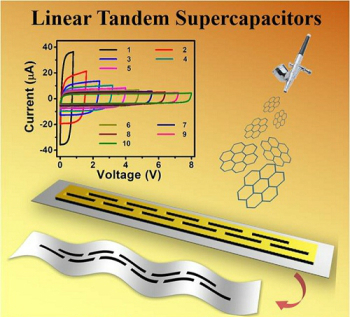ã€Chinese Instrument Network Instrument R&D】 Recently, Wu Zhongshuai, a researcher of the 2D Materials and Energy Device Research Group of the Dalian Institute of Chemical Physics, Chinese Academy of Sciences, and the Academician of the Chinese Academy of Sciences Baoxin cooperate with the new concept, planarization, self-integrating graphite-based supercapacitor New progress was made in the research and it was first proposed that a graphene-based linear series supercapacitor with high voltage output be efficiently produced by spray coating. The related results were published in Advanced Materials.

The rapid development of miniaturized and flexible electronic devices has stimulated people's demand for miniature energy storage devices. Conventional single supercapacitors have a low output voltage (<1.0V in water system). When multiple non-planar energy storage devices are connected in series, the processing steps are complex and need to use metal connectors, which reduces the modular integration and mechanical flexibility of the supercapacitors. It is difficult to meet the application requirements of future electronic devices for high-voltage real-world scenarios. Therefore, there is an urgent need to develop innovative device configurations and large-scale device manufacturing methods to achieve the purpose of efficiently preparing a novel energy storage device having a high voltage output.
The research team used a mixture of electrochemically exfoliated graphene and conductive polymer PH1000 (poly 3,4-ethylenedioxythiophene-polystyrene sulfonic acid) as a highly conductive ink, with the aid of a mask, using a spraying method. A planar supercapacitor module with ten linear devices integrated in series was prepared on A4 paper. The resulting device has good mechanical flexibility and can stably output a high voltage of 8V in the aqueous electrolyte without the need of a metallic connector. In order to increase the specific capacity of a single device, high-capacity polyaniline-functionalized graphene is used as an electrode material, and a linear series supercapacitor manufactured likewise has a high tantalum capacitance and maintains good series behavior. In order to further increase the output voltage of a single device, two kinds of two-dimensional materials, manganese dioxide nanosheets and electrochemical stripping graphene, were selected as anodes and cathodes of supercapacitors, respectively, to produce asymmetrical linear series supercapacitors on a substrate. This increases the output voltage from 1.8V for a single asymmetric supercapacitor to 5.4V for three linear series supercapacitors, further increasing the device's output voltage and energy density. Studies have shown that graphene and other two-dimensional materials have wide applicability in manufacturing linear series supercapacitors with symmetrical and asymmetric structures, and provide new strategies for manufacturing planar, flexible, and integrated energy storage devices.
The research work was supported by the National Natural Science Foundation of China, the National Key Research and Development Program, the National Youth 1000-Year Plan, the Natural Science Foundation of Liaoning Province, the Knowledge Innovation Project of the Dalian Institute of Chemicals, and the Extended Petroleum Exploratory Research Project.
(Original Title: Research Progress of Graphene Alkenyl Linear Series Supercapacitors by Dalian Institute of Chemical Industry)